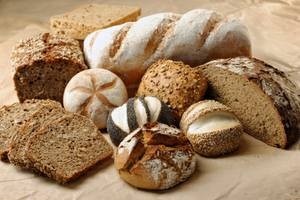Divide your dough into the number of pieces you require, cover with a dampened cloth or greased polythene and leave to relax for 5 minutes. This makes the dough easier to shape.

Bread Shapes
If the loaf is to be baked in a tin or pot, mould it to an appropriate shape, fit into the warmed and greased container and cover it for the final rising or proving.
There are a lot of different traditional shapes that you can make with your home made dough – the big advantage over most bread-making machines.
Bloomer Loaf
Mould the dough into a fat sausage shape, put onto a warmed, greased baking tray. Cover and put to rise. After 25 minutes, make diagonal cuts across the loaf, ¼”(6 mm) deep and 1 ½” (3.5 cm) apart with a sharp knife. Re-cover and put back to rise for a further 15 minutes before baking.
Bread Rolls
Divide the dough into 1-1 ½ oz (25-40 gram) pieces and form into rolls. Place the rolls on a warmed and greased baking tray, cover and put to rise until they have doubled in size before baking.
- Crescents – Roll the dough to a square. Cut in half diagonally to form triangles. Roll each triangle up from the base to the top and draw the ends together to form crescents.
- Plaits – Roll out the dough. Cut in oblongs 1 ½” x 3” (3.5 cm x 7 cm), cut each oblong twice through its length to within 1” (2.5 cm) of one end. Plait up and seal the loose ends with water and pressing together.
- Twists – Roll out the dough, cut in oblongs 1 ½” x 3” (3.5 cm x 7 cm). Hold one end and twist the dough two or three times.
- Vienna Rolls – Form into rolls about 3” (7.5 cm) long, thicker in the centre than at each end. Make 3 cuts diagonally across the top with a sharp knife.
Cottage Loaf
Cut off 1/3 rd of the dough and shape both the large and smaller pieces into smooth balls. Slightly moisten the base of the smaller ball with water and sit it on top of the larger ball and put onto a warmed, greased baking tray.
Push the first two fingers of both hands down from the centre of the top ball into the bottom ball to seal the balls together.
Cover and put to rise for 40 minutes. If you wish, after 20 minutes, you can make small downward slits with a sharp knife at 2” (5 cm) intervals all round the side of the upper and lower parts of the loaf.
Plaited Loaf
Divide the dough into either 3 or 5 equal pieces and roll each piece into a long sausage. Plat loosely and seal both ends firmly with water and pressing together. If you’re good at platting, you can do this with 7 equal pieces! Put onto a warmed, greased baking tray, cover and put to rise for 30 – 35 minutes before baking.
Split Coburg Loaf
Mould the dough into a smooth ball, put onto a warmed and greased baking tray. Cover and put to rise. After 20 minutes, cut a cross ½” (1.25 cm) deep into the surface of the loaf with a sharp knife. Put back to rise for another 20 minutes before baking.
Split Tin Loaf
When the loaf has risen in its tin for about 25 minutes, make a cut ½” (1.25 cm) deep from end to end along the centre of the loaf with a sharp knife. Re-cover and put the loaf back to rise for a further 15 minutes before baking.


